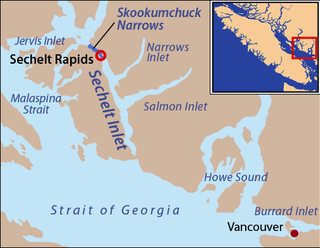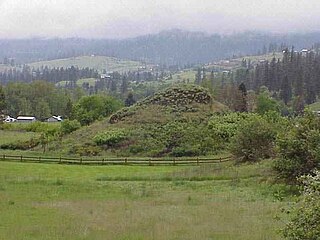Chinook Jargon is a language originating as a pidgin trade language in the Pacific Northwest. It spread during the 19th century from the lower Columbia River, first to other areas in modern Oregon and Washington, then British Columbia and parts of Alaska, Northern California, Idaho and Montana while sometimes taking on characteristics of a creole language. It is partly descended from the Chinook language, upon which much of its vocabulary is based. Approximately 15 percent of its lexicon is French, and it also makes use of English loanwords and those of other language systems. Its entire written form is in the Duployan shorthand developed by French priest Émile Duployé.

The Yakama are a Native American tribe with nearly 10,851 members, based primarily in eastern Washington state.

Chinookan peoples include several groups of Indigenous people of the Pacific Northwest in the United States who speak the Chinookan languages. Since at least 4000 BCE Chinookan peoples have resided along the Lower and Middle Columbia River (Wimahl) from the river's gorge downstream (west) to the river's mouth, and along adjacent portions of the coasts, from Tillamook Head of present-day Oregon in the south, north to Willapa Bay in southwest Washington. In 1805 the Lewis and Clark Expedition encountered the Chinook Tribe on the lower Columbia.

The Skookumchuck River is a 45-mile (72 km) long river located in southwest Washington, United States. It is a tributary of the Chehalis River and thence to the Pacific Ocean. The Skookumchuck Dam was built in 1970, creating the Skookumchuck Reservoir. The dam provides water supply for the 1400-megawatt Centralia Steam Electric Plant and supplements flows for fish resources. The river begins with several tributaries in the Snoqualmie National Forest in the foothills of the Cascade Mountains, and flows west past the town of Bucoda, Washington to its confluence with the Chehalis River near Centralia, Washington.

Skookumchuck Narrows is a strait forming the entrance of Sechelt Inlet on British Columbia's Sunshine Coast in Canada. Before broadening into Sechelt Inlet, all of its tidal flow together with that of Salmon Inlet and Narrows Inlet must pass through Sechelt Rapids. At peak flows, standing waves, whitecaps, and whirlpools form at the rapids even in calm weather. The narrows are also the site of Skookumchuck Narrows Provincial Park.
The Haisla language, X̄a'islak̓ala or X̌àh̓isl̩ak̓ala, is a First Nations language spoken by the Haisla people of the North Coast region of the Canadian province of British Columbia, who are based in the village of Kitamaat. This is 10 km from the town of Kitimat at the head of the Douglas Channel, a 120 km fjord that serves as a waterway for the Haisla and for the aluminum smelter and accompanying port of the town of Kitimat.

Indigenous peoples of the Northwest Plateau, also referred to by the phrase Indigenous peoples of the Plateau, and historically called the Plateau Indians are indigenous peoples of the Interior of British Columbia, Canada, and the non-coastal regions of the Northwestern United States.

Keish, also known as James Mason and by the nickname Skookum Jim Mason, was a member of the Tagish First Nation in what became the Yukon Territory of Canada. He was born near Bennett Lake, on what is now the Yukon–British Columbia border. He lived in Caribou Crossing, now Carcross, Yukon.

Sechelt Inlet formerly Seechelt Inlet is one of the principal inlets of the British Columbia Coast. The inlet is significant in that it almost makes an island of what is instead the Sechelt Peninsula, whose isthmus is at the town of Sechelt at the head of the inlet. The isthmus is less than 1.2 km (0.75 mi) in distance. Sechelt Inlet's mouth is at Jervis Inlet, inland from the Malaspina Strait.
Skookumchuck is a Chinook Jargon term that is in common use in British Columbia English and occurs in Pacific Northwest English. Skookum means "strong" or "powerful", and "chuck" means water, so skookumchuck means "rapids" or "whitewater", or fresh, healthy water. It can mean any rapids, but in coastal usage refers to the powerful tidal rapids at the mouths of most of the major coastal inlets.
Pacific Northwest English is a variety of North American English spoken in the U.S. states of Washington and Oregon, sometimes also including Idaho and the Canadian province of British Columbia. Due to the internal diversity within Pacific Northwest English, current studies remain inconclusive about whether it is best regarded as a dialect of its own, separate from Western American English or even California English or Standard Canadian English, with which it shares its major phonological features. The dialect region contains a highly diverse and mobile population, which is reflected in the historical and continuing development of the variety.
Mesachie Lake is an unincorporated community in the Cowichan Valley region of Vancouver Island, British Columbia, Canada. It lies on the south shore of Cowichan Lake, British Columbia. The name is from the Chinook Jargon for "bad, evil, naughty". It was founded in 1942 by the Hillcrest Lumber Company, which built houses for its workers and their families. This company also planted many non-native fruit and shade trees which have since been given heritage status.

The Entiat River is a tributary of the Columbia River, joining the Columbia near Entiat. The United States Geological Survey (USGS) lists two variant names for the Entiat River: En-ti-at-kwa River and Entiatqua River. The river's name is derived from the Columbia-Moses (Salishan) term /nt'yátkw/ [nt'iátkw], meaning "place of grassy water"; another source states that it was called Enteatqua which means "Rapid Water" or "Rushing Water." The name, spelled "Entiat", was selected for the river in 1958 by the Chelan County Public Utility District.
Nootka Jargon or Nootka Lingo was a pidginized form of the Wakashan language Nuučaan̓uł, used for trade purposes by the indigenous peoples of the Pacific Northwest Coast, when communicating with persons who did not share any common language. It was most notably in use during the late 18th and early 19th centuries and was likely one precursor to Chinook Wawa, in Chinook Wawa's post-contact-form. A small number of words from Nuučaan̓uł form an important portion of the lexical core of Chinook Wawa. This was true, both in Chinook Wawa's post-contact pidgin phase, and its latter creole form, and remains true in contemporary Chinuk Wawa language usage.

A Skookum doll was a Native American themed doll, sold as a souvenir item in the early 20th century. Although considered collectible, they are not authentic Native American dolls, as they were designed and created by a white woman, and quickly mass-produced.
John Ogilvie "Skook" Davidson, MM & two bars was a soldier, land surveyor, packer, guide and rancher in far northern British Columbia, Canada. Known as "Skook" or "Skookum" Davidson because of his stature, he is the namesake of Mount Skook Davidson and the Liard River landing Skooks Landing was so-named because it was where he would arrange to have supplies dropped for his Diamond J Ranch, which lay up the Kechika River 150 miles from there. He moved to Vancouver in 1972 following a fire at the ranch. The location is near Fireside, British Columbia and near it is an old construction camp used by crews building the Alaska Highway, the route of which he helped discover.
Mount Skook Davidson, 2,382 metres (7,815 ft), is a mountain in the Kechika Ranges of the Cassiar Mountains in far northern British Columbia, Canada. It overlooks the "Diamond J Ranch", which was founded by John Ogilvie Davidson also known as "Skook" Davidson or "Skookum" Davidson because of his stature. Davidson was a notable local pioneer who worked as a land surveyor before taking up packing, guiding, and ranching in this area. He helped discover and select the route for the Alaska Highway.








